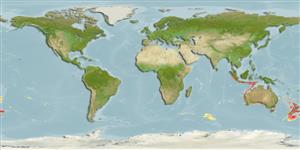Classification / Names
Common names | Synonyms | Catalog of Fishes (gen., sp.) | ITIS | CoL | WoRMS | Cloffa
Actinopterygii (ray-finned fishes) >
Gadiformes (Cods) >
Macrouridae (Grenadiers or rattails) > Macrourinae
Etymology: Coelorinchus: Greek, koilos = a hollow + Greek, rhyngchos = jaw (Ref. 45335).
Environment / Climate / Range
Ecology
Marine; bathydemersal; depth range 300 - 800 m (Ref. 26363). Deep-water, preferred ?
Southwest Pacific: Australia (New South Wales to Victoria and Tasmania) and New Zealand.
Size / Weight / Age
Maturity: Lm ? range ? - ? cm
Max length : 28.5 cm TL male/unsexed; (Ref. 26363)
Short description
Morphology | Morphometrics
Dorsal
spines
(total): 2. Several faint dark dorsal saddle marks on the posterior half of the body; pale intervening marks about the width of two scale rows; naked ventral surface of head and lower jaw (some with 1-3 scales beside articulation of lower jaw); dorsal anterior snout with naked triangular areas; naked below nostrils to suborbital ridge; large well-developed oval dermal window of light organ separated from anus by 2-3 rows of scales; lateral and medial processes of nasal bone not continuous (Ref. 26363). Resembles Caelorinchus maurofasciatus, C. mystax, C. bollonsi, C. cookianus, and C. fasciatus. Differs from C. mystax, C. bollonsi, and C. fasciatus in numbers of pyloric caeca (22-28 versus 111-115, 27-38, 12-23, respectively) in addition to other characters (Ref. 26363). C. parvifasciatus has similar numbers of pyloric caeca to C. maurofasciatus and C. cookianus but differs in having saddle markings only on the posterior half of the body (Ref. 26363).
A benthic species found on the continental slope (Ref. 75154).
Life cycle and mating behavior
Maturity | Reproduction | Spawning | Eggs | Fecundity | Larvae
McMillan, P.J. and C.D. Paulin, 1993. Description of nine new species of rattails of the genus Caelorinchus (Pisces, Macrouridae) from New Zealand. Copeia 1993(3):819-840. (Ref. 26363)
IUCN Red List Status (Ref. 115185)
CITES (Ref. 94142)
Not Evaluated
Threat to humans
Harmless
Human uses
More information
Common namesSynonymsMetabolismPredatorsEcotoxicologyReproductionMaturitySpawningFecundityEggsEgg development
Age/SizeGrowthLength-weightLength-lengthLength-frequenciesMorphometricsMorphologyLarvaeLarval dynamicsRecruitmentAbundance
ReferencesAquacultureAquaculture profileStrainsGeneticsAllele frequenciesHeritabilityDiseasesProcessingMass conversion
Tools
Special reports
Download XML
Internet sources
